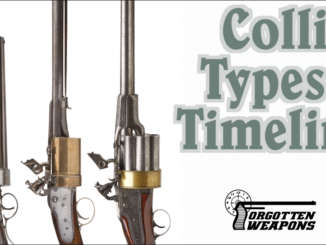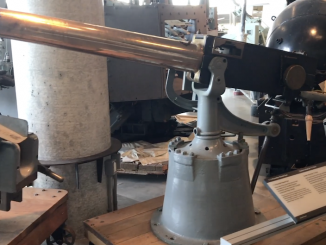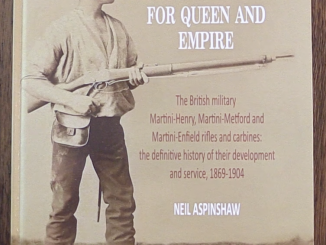The Prideaux speed loader was one of several early such devices patented and manufactured as early as 1893, but neither it nor any competitor saw much demand until the outbreak of World War One. At that point, a substantial number were purchased privately by individual officers for use in the trenches – enough that they came to the attention of the British military administration. In October of 1918 the Prideaux specifically was formally adopted by the British military, although none were procured until after the war ended – all surviving military examples show 1919 dates.
Related Articles

Antiques
Clockwork to Percussion: Collier Revolver Types and Timeline
“Clockwork Basilisk: The Early Revolvers of Elisha Collier and Artemas Wheeler” is available right now for preorder on Kickstarter: https://www.kickstarter.com/projects/headstamp/clockwork-basilisk?ref=1s3pxu What were the different patterns of Collier, and what was the timeline of their development […]

Artillery
Quick Look at a 37mm Maxim “Pompom” Automatic Cannon
This Vickers, Sons & Maxim 37mm MkIII “Pompom” is on display at the Canadian War Museum in Ottawa. The MkIII pattern is quite scarce, with less than one hundred ever made. It is built around […]

Book review
Book Review: The Martini Henry, For Queen and Empire
One of the perennial challenges facing authors of firearms reference books is balancing the very technical nit-pickery with the broad historical view of a gun and its context in world events. The emphasis is usually […]

The little ring on the end facilitated hanging the loaders around one’s neck, not unlike the lanyard loop that kept you hooked to your handgun. There are illustrations floating about of officers on trench raids wearing two or three reloads hanging down their chests. Nowhere on the web is their video of the Prideaux itself being reloaded. Too late to rectify this?
I am told the .38 Prideaux for the Mark IV Webley will happily reload modern S&W K-frame revolvers. There might be a market for those fakes, they wouldn’t even have to be rendered as fakes.
edit: nowhere is there video, not their. No spellcheck in the morning. Their chests is correct. Sorry, I did mess up.
It would be interesting to know a little more about the history of speedloaders in general. I have seen drawings, but not a photo, of a 2-piece wood-core speedloader with a separate metal ring to hold the rounds that was apparently intended for use with the 1892 Colt.
I think you have searched Carl J. Ehbets’s “cartridge feed pack for revolvers” (US patent 402,424, patented Apr. 30, 1889.). Here your are: [https://patentimages.storage.googleapis.com/24/24/16/f87e368d893fa2/US402424.pdf]. A photo can be found here: [http://www.mcpheetersantiquemilitaria.com/09_guns_parts/09_item_038.htm].
I’m always fascinated by cool devices from the time before plastics.
“(…)cool devices from the time before plastics.”
If you are interested in advertisement of above described Prideaux Speedloader see 1st image from top: https://laststandonzombieisland.com/tag/lcr-speedloader/
otherwise ignore this post entirely
Note that interestingly this device was called Magazine back then, which might be confused for modern reader.
Assuming that a magazine was merely a container for reserved ammunition, calling a speed-loader a magazine made sense in the old days. I could be wrong.
I could watch Ian load a Webley-Fosbery w/ this speedloader all day.
So it will work with a Webly in .45 Auto Rim/?ACP conversion?
I gotta wonder if the speedloaders were issued out in WW2….or were they surplussed when the UK went to the 38-200 from the 455
I think you might be interested in:
Nigel Uttig: Prideaux’s Improved Patent Magazine Loader for Rapidly Loading Revolvers
https://web.archive.org/web/20191019063411/http://utting.org/writing/nvtu/shooting/prideaux-loader.pdf
William de Courcy Prideaux was my great uncle. He also developed and patented a non-jamming machine gun belt. The Imperial War Museum in London holds a number of his papers. He was a dentist by profession, living in Dorset UK, but also heavily involved in archeology. One of his brothers was curator of the Dorset County Museum, the other, my grandfather, was a superb shot and won a lot of prizes for shooting.